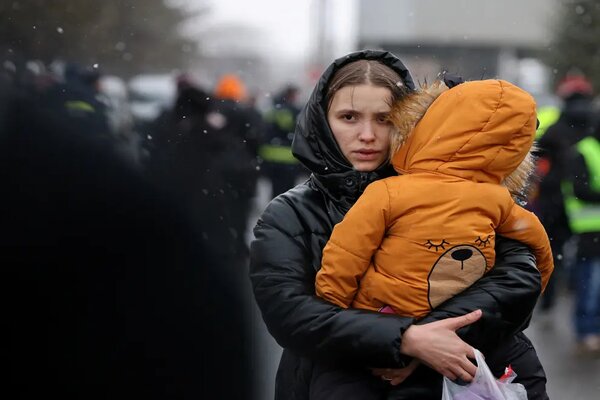In a desperate bid to escape from war, children from across Ukraine are being sent to cross borders, without their parents or their legal guardians. What happened to these children? Authorities are reporting that 5,000 are unaccounted for; fearing some may have been trafficked.
A team of US military veterans is helping to organise safe passage for the estimated 200,000 children in Ukraine’s orphanages and foster homes. But they say thousands are unaccounted for and fear some may already have fallen prey to people traffickers.
The International Rescue Committee (IRC) warns that of the over 1.5 million refugees that have fled Ukraine since the Russian invasion, the vast majority are women and children at grave risk of violence, exploitation and abuse. The speed of displacement seen in this crisis is unprecedented. We have not seen displacement taking place at such a pace since the Rohingya crisis.
As the numbers of displaced people grow daily, the UN warns that up to 5 million people could flee the country – making this the biggest humanitarian crisis in Europe since World War II. In crisis settings, women and girls face particular and disproportionate risks – including of violence, exploitation and abuse – during conflict and displacement. Women and girls fleeing Ukraine will be no different.
According to UNICEF Executive Director Catherine Russell and United Nations High Commissioner for Refugees Filippo Granditill first week of March, 2022, more than one million refugees have been forced to flee Ukraine seeking safety and protection. Hundreds of thousands of them are children. Amongst those fleeing, many are unaccompanied or have been separated from their parents or family members.
They expressed concern that children without parental care are at a heightened risk of violence, abuse and exploitation. When these children are moved across borders, the risks are multiplied. The risk of trafficking also soars in emergencies.
UNICEF and UNHCR urged all neighbouring and impacted countries to ensure the immediate identification and registration of unaccompanied and separated children fleeing from Ukraine, after allowing them access to their territory.
“States should offer safe spaces for children and families immediately following border crossings, and link these to national child protection systems. The current emergency also necessitates rapidly expanding the capacity of emergency care arrangements with screened caregivers as well as other critical services for the protection of children, including against gender-based violence, as well as family tracing and reunification mechanisms”, they added.
They suggested that for children who have been displaced across borders without their families, temporary foster or other community-based care through a government system offers critical protection. Adoption should not occur during or immediately after emergencies. Every effort should be made to reunify children with their families when possible, if such reunification is in their best interest.
As per UNICEF and UNHCR estimation, nearly 100,000 children, half of them with disabilities, live in institutional care and boarding schools in Ukraine. Many of these children have living relatives or legal guardians. We have received reports of institutions seeking to move children to safety in neighbouring countries or beyond.
While recognizing that, under specific circumstances, humanitarian evacuations can be lifesaving and welcoming efforts to bring children to safety, it is critical that special measures be taken in the best interest of the children, and that the consent of their parents or persons responsible for their care be granted.
UNICEF and UNHCR cautioned that under no circumstances should families be separated as a result of relocation or evacuation movements. Those legally responsible for children in institutions in Ukraine must ensure that evacuations are done in line with national authorities’ instructions. Movements must be reported to competent authorities in Ukraine and neighbouring countries immediately upon crossing the border, and as far as possible, children should be evacuated with their identification papers and case files.
A team working on the Ukraine-Poland border has seen how easy it is for traffickers to find victims. The BBC spoke to Martin Kvernbekk, who works for a charity supporting refugees, reporting:
He has heard about children going missing from a number of different sources, and reports of people smugglers wearing reflective vests and pretending to belong to organisations helping the relief effort.
“The gangs are very advanced – it’s big, well-financed networks that do this for a living. They’re good at this in peace time,” he says. “Now it’s a war, its chaos, and they’re exploiting the fact there is disorder to be able to snatch more kids and women.”
Freedom United said that a million children are estimated to be living in conflict zones within Ukraine and around 200,000 children in Ukraine are looked after by the state in orphanages and foster homes. These children are made vulnerable by their circumstances and traffickers are ready to exploit that vulnerability.
The EU Commissioner for Home Affairs, Ylva Johansson, voicing concerns said, “We also have some reports of criminals taking orphans from orphanages in Ukraine, crossing the border pretending that they are relatives to the child and then using them for trafficking purposes.”
Without a system in place to record or check information, it is not possible to know what has happened to the missing children or how many may have been trafficked. Systems are now improving and safety protocols are being put in place. The BBC reports that the Ukrainian authorities are working with NGOs to process displaced



